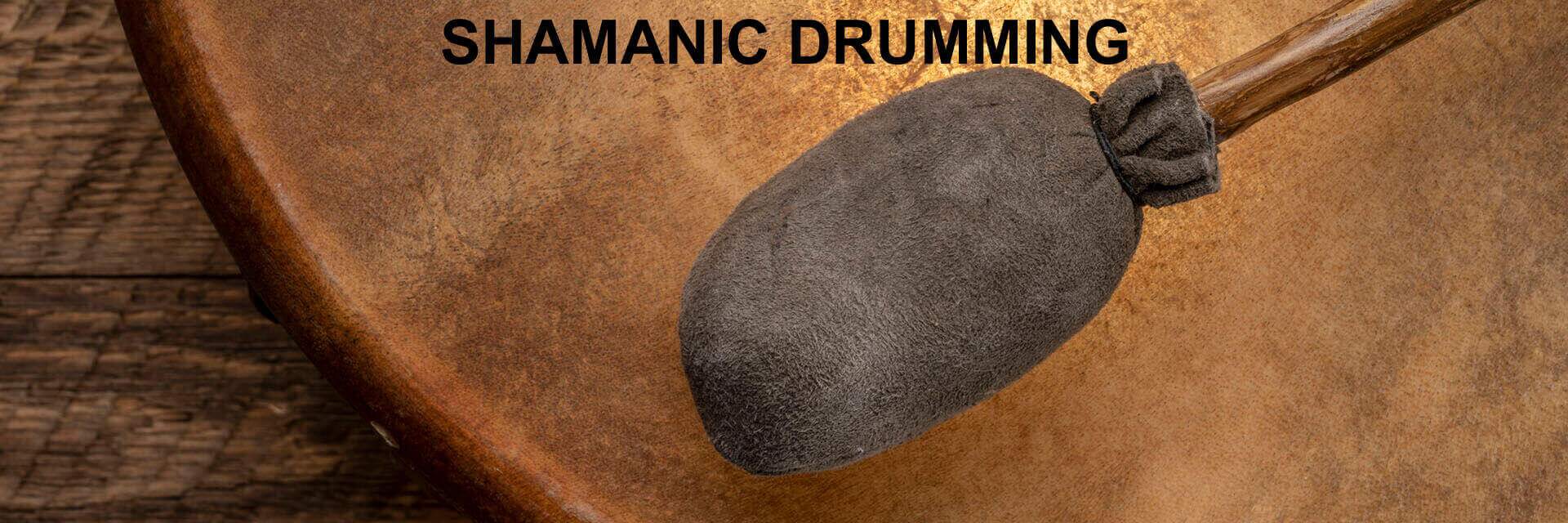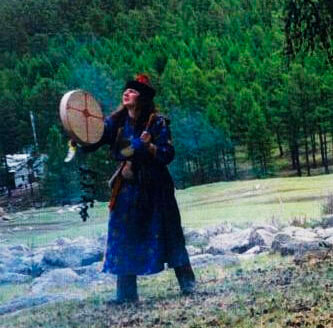


The 'Hese Amiluulah' ritual is a Mongolian way of dedicating a shaman's drum. Mongolian shaman Sarangerel Odigon shares a simple way that you can perform the ceremony yourself.
The Drum (hese hengereg) is the most well-known tool of a shaman, for its sound drives the shamanic journey1 and its rhythms represent the hoof beats of the shaman's magical mount.
Siberian drums tend to be relatively large, twelve to twenty inches in diameter on average with the drumhead decorated both inside and outside in a way that has spiritual significance for the shaman. It is customary among Mongolian and Siberian shamans to attach bells to the inside of the drum so that the drum can be shaken as well as struck.
Shamans recognize certain parts of the drum as being the top, bottom, left, and right sides. Ribbons and hadags2 are tied to the top, left, and right sides of the drum to represent the crown and ears of the drum.
The drumstick, or orba, is also a significant tool. In fact, it has certain independent uses. A Siberian or Mongolian drumstick is usually rather spoon-shaped. It is six inches to a foot long, with a distinct front and back side. Fur or soft leather covers the striking side; while the back side has rings attached that jingle with the motion of the drumstick. Usually the rings are strung on a wire, but they may be stapled to the drumstick in a way that allows them to jingle against each other so the drumstick can also function as a type of rattle. The drumstick is also usually decorated with streamers to match the drum.
I present this ritual here as a good example of how shamans connect with the spirits of their instruments so that they can be used more effectively. Many of you are probably using, or will be using drums in your shamanic work, so this should be especially relevant for you. Once you become familiar with this procedure, you can adapt it easily for the awakening (amiluulah) of other shamanic implements, such as rattles, staffs, and ritual weapons. Remember, the chief aim of awakening rituals is for the shaman to connect with the ezen3 of the object being awakened so that it will become a helper spirit.
Before you awaken the drum, spend some time meditating on it and where it came from. What is the head made out of? Is it artificial, or is it skin? If it is skin, what kind is it? What kind of wood is it made out of? Do you know where it was made? If the drum has a head or rim made of plastic, consider how plastic comes from petroleum, which is the essence of many animals and plants that lived in ancient times. After all, unless your drum is made out of metal, its parts all come from things that were alive at one time.
An important part of this ceremony will be the visualization of the living things from which the drum was made, so thinking about it beforehand will make this part of the awakening of the drum much easier. As I mentioned above, the ezen of the drum enters at the time of its making. It is especially magical if it happens that you made the drum yourself, for the ezen would have passed through your hands into the drum as you made it: both the time of creation and the time of awakening are one, even if they seem separated in our perception of linear time. In Siberia it is traditional for a drum to be given to a shaman rather than for a shaman to buy it, although there are exceptions. A drum is usually given to a shaman by clients or family members in honor of, and gratitude for the work he is doing. Indeed, a drum that is gifted is a great blessing, for it is a sign that the spirits have selected a specific drum for a shaman and brought it into his possession.
It is not unusual for a shaman to have multiple drums; after all, with the passage of time, drums become worn out and need to be replaced with something that has a better sound and a tighter head. If you bought your drum, this does not lessen the effectiveness and power of this ritual; outside Siberia shamans tend to serve much smaller groups of people and are not often compensated for their work with shamanic instruments, as is the custom among Buryat shamanists. Also, it is customary to paint the head after the awakening of the drum, but if your drum has already been painted, do not worry about it. Another interesting custom is to have children play with the drum before its awakening. The spirit of the drum seems to enjoy being played with by people other than the shaman before the awakening ritual. When I do the drum awakening in workshops, I fulfill this custom by allowing the participants to pass their drums around the ritual circle. Everyone drums on each of the drums a little before passing it on to the next person. It is fun, and the joy of the drum spirits in being handled in this way is great - the energy is palpable as the drums go around the circle. The playing with the drum or drums is the first part of the ritual. If you have children, let them play with the drum a little, then let others who will be in the ritual circle play. Apparently the happiness that comes out of play is stimulating to drum spirits. Incidentally, this ritual action is not done in the awakening of other shamanic instruments; although it could probably be done with rattles or bells (it would be unthinkable, after all, to have a child play with ritual weapons!).
To prepare for this ceremony, meditate on the drum. Have someone else play the drum before you do the journey.
Needless to say, this should be done in a ritual space indoors or outdoors - I sometimes do this ceremony by a campfire.
Once you have made invocations to the spirits you normally honor in your work, be sure to make an invocation to the drum spirit and ask it to come to you and become your ally. Now, if you have not had the drum played in advance, have somebody else play your drum before it becomes bonded with you.
When you awaken the drum you should play alone, or if you are doing this with other people, you set the speed and rhythm of the drumming. As you become more focused, ask the drum spirit to show you the place where the animals who provided the skins lived, what they looked like, how old they were when they were taken. Ask the drum spirit to show you the tree from which its wood was cut. If you have plastic parts to your drum, ask the drum spirit to show you what kinds of animals provided the essence for the chemicals that the plastic is made of. If the drum has metal parts, imagine the place from which the metal was mined and smelted. Close your eyes. Imagine yourself on a mountaintop, waiting for the drum spirit to come to you.
Allow the rhythm of the drum to become as natural as your breath, your heartbeat. Allow the drum spirit to merge with you so that the speed and rhythm of your drumming will be controlled by it as you become ongod orood4.
Do not be surprised by the appearance of the spirit of the drum. Perhaps it will appear as a heroic steed, but remember, the shamanic mount can manifest itself as any kind of natural or fantastic creature. Let it show you the places where its components came from, what forest the wood came from, what kinds of animals gave themselves to the making of the drum.
You may even have a vision of when the drum was being made and the spirit entered into it. The spirit may teach you some special ways you can use the drum for your shamanic work that you did not know before - your drum spirit and your udha5 together are instructing you in powerful ancient shamanic knowledge when this happens!
As you continue to drum, you will become more ecstatic and the spirits will create new rhythms and perhaps cause you to sing. You are now stepping into a higher level of shamanic consciousness and skill. At some point in your journey, you - like other shamans of the past - will realize that all your helper spirits and power animals are traveling at your side and rejoicing that you have merged with the spirit of the drum. Now you have obtained the power to do much greater things than you were able to do before. You will not realize the full magnitude of this change until a few days or even a couple of weeks afterward.
This kind of initiatory ceremony is called shanar (best translated as increase in ability) and it is a time of great celebration.
When this is performed as a ritual with many participants, the ceremony is followed by a festive meal in which the shaman or shamans are honored and the people rejoice that the spirits have brought the blessing of greater power to the shamans for the benefit of the community and of mankind.
NOTES:
1: A shamanic journey is an altered state of consciousness where the
shaman's spirit leaves their body in order to fly to other worlds in the shaman's
cosmology.
2: Hadags are silk offering scarves.
3: Ezen are the spirits of a place or of an object.
4: Ongod orood is an altered state of consciousness where a shaman's spirit
helper takes possession of a shaman's body.
5: The udha are shamans' chief helper spirits who will generally assist shamans
as well as teaching and instructing them.
Sarangerel Odigon was an American of Mongolian descent. As an adult she returned to live in the place of her ancestors and studied Mongolian shamanism for many years. She was the author of two books on Tengerism (Mongolian shamanism). She traveled across the globe passing on the teachings of her people to all who wanted to learn them. Sadly, in 2006 she passed into spirit.
This copyrighted article was reprinted with permission from Sacred Hoop Magazine at WWW.SACREDHOOP.ORG
Preview our Digital Books and Music
Affiliate disclosure: As an Amazon Associate, we earn from qualifying purchases. You can learn more about our editorial and affiliate policy here. Music Attribution.
© 2001 - 2025 Talking Drum Publications